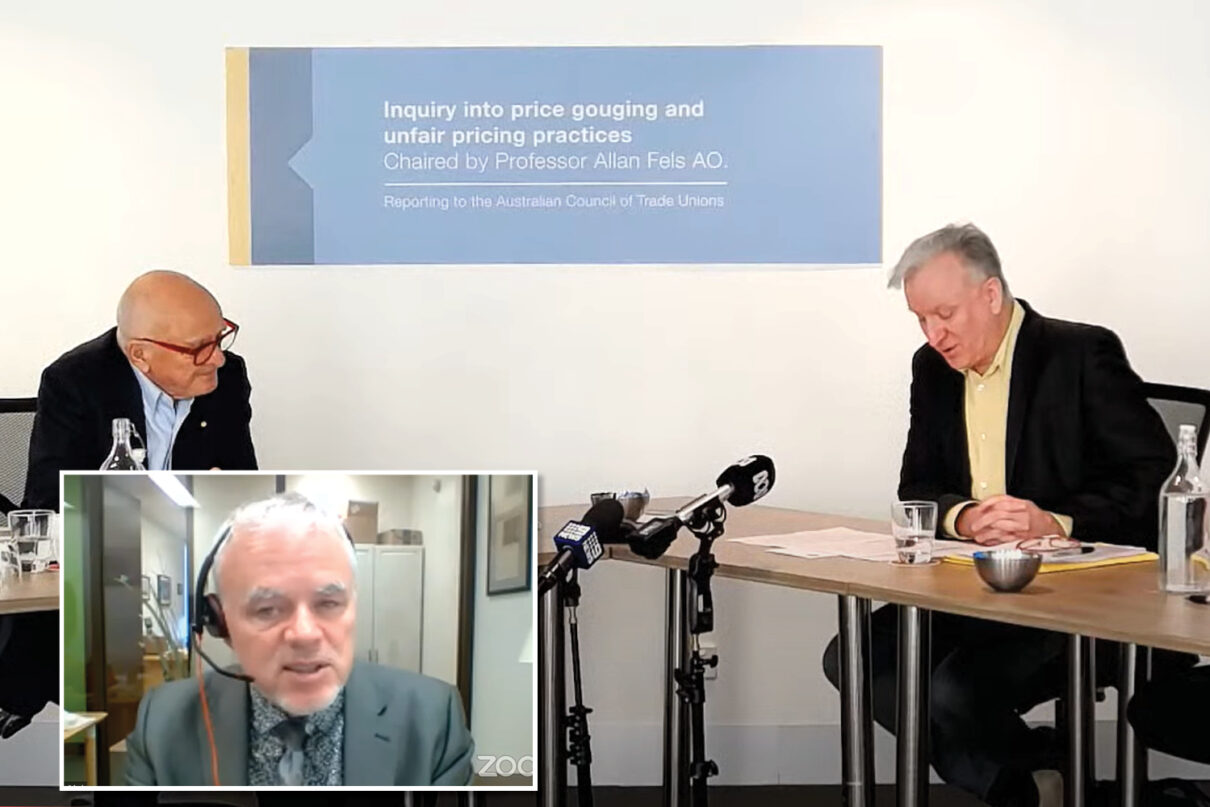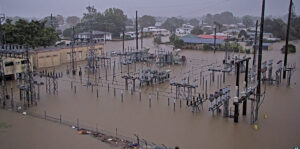Opening statement to the ACTU Price Gouging Inquiry

This week Professor Allan Fels, the former head of the Australian Competition and Consumer Commission (ACCC), has begun an inquiry into price gouging across a range of industries, including banks, insurance companies, supermarkets, and energy providers. The inquiry commissioned by the ACTU comes off the back of the highest inflation in 30 years and the biggest falls in real wages on record.
The Director of the Centre for Future Work, Jim Stanford and policy director and chief economist of the Australia Institute, Greg Jericho, presented evidence at the inquiry based on their research into profit-led inflation. Below is an edited excerpt of their opening statement.
The recent period of rising inflation has been highly unusual coming as it has after a period where in Australia, core inflation by June 2021 had not been above the Reserve Bank’s target range of 2% to 3% for more than a decade and had been below 2% for five and half years.
Perhaps unsurprisingly, because of such a long period without rising inflation, we saw very much a default to the thinking of the 1970s and a belief that all inflation is primarily driven by demand factors that need to be limited by higher interest rates.
This was a fundamental misunderstanding of this inflationary period. It clearly could not be driven by wages because wages at all stages over the past two years have grown on average by less than inflation, such that real wages are now 5.5% below what they were two years ago.
Wage growth in the 12 months to June this year was just 3.6%, still well below the CPI of 6%, and far from accelerating, actually had fallen from 3.7% growth in the 12 months to March.
Thus, the question becomes, if not wages, what?
Our research in February this year revealed that the initial surge of inflation in Australia beginning in mid-2021 was closely associated with a surge in price pressures.
Business profits were the dominant manifestation of that inflation. The supply shocks that occurred because of the pandemic lockdowns and Russia’s invasion of Ukraine allowed companies in some key industries (such as energy, logistics, and manufacturing) to significantly boost their profit margins, coincident with rising prices.
Our February 2023 paper, using the decomposition method of the national accounts (as explained by Jim), concluded that since the end of 2019, 69% of unit price increases over and above the RBA’s 2.5% inflation target mid-point were attributable to increased nominal unit profit payments. Only 18% was attributable to higher nominal unit labour costs, and the rest to increases in other nominal factor payments.
Our paper noted that the profit growth was most dramatic in the energy and resources sector. These findings were broadly consistent with the findings of earlier research by the Australia Institute, as well as with the similar decompositions of inflation reported in other countries.
Our follow-up report in April confirmed the leading role played by profits in the energy and resource industries. It noted that products from that sector (including petrol, gas, and other fossil fuel-intensive products) were leading sources of domestic inflation in Australia. It also showed that profits in other sectors, such as wholesale trade (56%), manufacturing (38%), professional and technological services (37%) and construction (37%), had also increased as a share of non-mining GDP since the pandemic. This profit growth is not dissimilar from the 48% growth in mining profits during the same period and well in excess of the 27% increase in nominal GDP.
This confirmed that firms across these sectors have more than simply passed on higher input costs to consumers. As American economist Isabelle Weber has argued, they amplified them.
The release of two more quarters of national accounts since February allows us to update our figures, which find that despite recent falls in corporate profits in some sectors, higher unit profit payouts still account for over half (56%) of the cumulative increase in nominal unit prices in the Australian economy since December 2019, above and beyond what would be expected due to normal target inflation. The role of higher unit labour costs in overall unit prices has increased in recent quarters and now accounts for just over one-third (35%) of the cumulative above-target rise in prices since the pandemic.
The influence of profits is clear when you consider that unit profit costs by June 2023 were 27% above their December 2019 levels (down from 37% above in March 2023), while unit labour costs are just 14% above December 2019 levels – pointedly just below the 15% growth in CPI.
There have been some suggestions by the Reserve Bank and others that our research should exclude mining profits as these do not significantly influence Australian inflation. Profits in mining during this time accounted for over half of all corporate profits in Australia; obviously, if over half of corporate profits are excluded from consideration, then profits will obviously seem less important.
We reject the argument that mining profits somehow “don’t count” – especially in regard to domestic inflation, given the critical role played by higher petrol, gas, and electricity prices in driving the initial post-pandemic surge in Australian consumer price inflation.
Clearly, there is a strong connection between energy prices, energy industry profits, and inflation experienced by domestic consumers (not to mention inflation experienced in other sectors of the economy).
The good news is that corporate profits have begun to moderate in the first half of this year. It is important to note the modest decline in gross operating surplus in some sectors has still left corporate profits as a share of national GDP well above pre-pandemic levels and far above longer-term post-war averages.
Nevertheless, even the partial moderation of record corporate profits has been associated with a significant and welcome deceleration of inflation. Consumer price inflation in Australia has slowed by over half in the last nine months: from an annualised peak of 8.9% in the first quarter of 2022 (led by surging energy costs) to just 3.4% in the June quarter of 2023 (not much higher than the top of the RBA’s target range).
Moreover, even in the later stages of this current inflation cycle, with profits stable or even falling and labour costs accelerating, it’s wrong to conclude that labour is now the ‘source’ of inflation: clearly, the rise in unit labour costs reflects efforts by workers to recoup real income losses experienced earlier in the inflationary cycle, which must still be ascribed to the initial profit-led shocks that started the whole process.
Blaming workers now for inflation because they are pursuing higher wages to recover lost living standards is like blaming a homeowner whose house has been set on fire for using too much water to put out the flames.
Even as it appears to be moderating, this period of inflation requires a rethink of our policy approaches.
We have made a number of policy recommendations, including:
- Price regulations in strategic sectors
- Fiscal transfers (such as windfall profits taxes combined with cost-of-living transfers to vulnerable households)
- Competition policy reforms
- Supports for wage increases in excess of current inflation for a sustained period of time to allow the repair of recent real wage reductions.
The biggest lesson from this period is that we need more policy tools in our inflation toolkit. Relying on monetary policy and higher interest rates only works if you think inflation is only ever produced by higher wages and strong aggregate demand.
We know that the future is more likely than not to feature further global shocks – not the least from climate change. Policymakers and central banks need to learn from the past two years and ready themselves to treat the broader causes of inflation and protect workers and households when companies seek to use crises as an opportunity to lift prices.
You might also like
Feeling hopeless? You’re not alone. The untold story behind Australia’s plummeting standard of living
A new report on Australia’s standard of living has found that low real wages, underfunded public services and skyrocketing prices have left many families experiencing hardship and hopelessness.
Climate crisis escalates cost-of-living pressures
A new report has found direct connections between the climate crisis and rising cost-of-living pressures. Failure to lower emissions now will only aggravate the crisis, with each moment of inaction compounding the pressure on households.
Want to lift workers’ productivity? Let’s start with their bosses
Business representatives sit down today with government and others to talk about productivity. Who, according to those business representatives, will need to change the way they do things?



